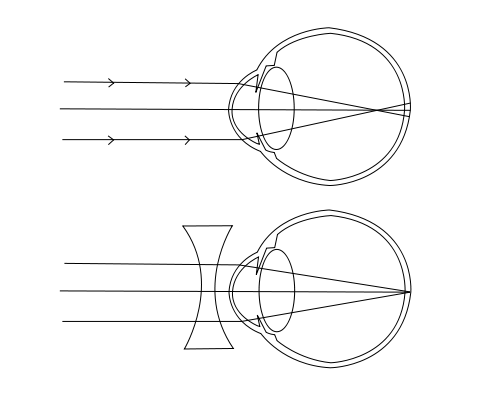Myopia overview: Difference between revisions
Saumya Easaw (talk | contribs) No edit summary |
Saumya Easaw (talk | contribs) No edit summary |
||
| Line 16: | Line 16: | ||
==Pathohysiology== | ==Pathohysiology== | ||
There are currently two basic mechanisms believed to cause myopia: [[form deprivation]] (also known as pattern deprivation<ref>http://arapaho.nsuok.edu/~salmonto/VSIII_2006/Lecture27.pdf </ref>) and [[defocus aberration|optical defocus]].<ref name="Saw 1">Saw SM, Gazzard G, Au Eong KG, Tan DT. [http://bjo.bmjjournals.com/cgi/content/short/86/11/1306 "Myopia: attempts to arrest progression."] ''Br J Ophthalmol.'' 2002 Nov;86(11):1306-11. PMID 12386095.</ref>Form deprivation occurs when the image quality on the [[retina]] is reduced; optical defocus occurs when light focus in front of or behind the retina. Numerous experiments with animals have shown that myopia can be artificially generated by inducing either of these conditions. In animal models wearing negative spectacle lenses, axial myopia has been shown to occur as the eye elongates to compensate for optical defocus.<ref name="Saw 1"/> The exact mechanism of this image-controlled elongation of the eye is still unknown. It has been suggested that [[accommodative lag]] leads to blur (i.e. optical defocus) which in turn stimulates axial elongation and myopia.<ref>Schor C. "The influence of interactions between accommodation and convergence on the lag of accommodation." ''Ophthalmic Physiol Opt.'' 1999 Mar;19(2):134-50.PMID 10615449.</ref> | There are currently two basic mechanisms believed to cause myopia: [[form deprivation]] (also known as pattern deprivation<ref>http://arapaho.nsuok.edu/~salmonto/VSIII_2006/Lecture27.pdf </ref>) and [[defocus aberration|optical defocus]].<ref name="Saw 1">Saw SM, Gazzard G, Au Eong KG, Tan DT. [http://bjo.bmjjournals.com/cgi/content/short/86/11/1306 "Myopia: attempts to arrest progression."] ''Br J Ophthalmol.'' 2002 Nov;86(11):1306-11. PMID 12386095.</ref>Form deprivation occurs when the image quality on the [[retina]] is reduced; optical defocus occurs when light focus in front of or behind the retina. Numerous experiments with animals have shown that myopia can be artificially generated by inducing either of these conditions. In animal models wearing negative spectacle lenses, axial myopia has been shown to occur as the eye elongates to compensate for optical defocus.<ref name="Saw 1"/> The exact mechanism of this image-controlled elongation of the eye is still unknown. It has been suggested that [[accommodative lag]] leads to blur (i.e. optical defocus) which in turn stimulates axial elongation and myopia.<ref>Schor C. "The influence of interactions between accommodation and convergence on the lag of accommodation." ''Ophthalmic Physiol Opt.'' 1999 Mar;19(2):134-50.PMID 10615449.</ref> | ||
==Physical Examination== | |||
A diagnosis of myopia is typically confirmed during an [[eye examination]] by an [[ophthalmologist]] or an [[optometrist]]. Frequently an [[autorefractor]] or[[retinoscope]]is used to give an initial objective assessment of the refractive status of each eye, then a [[phoropter]] is used to subjectively refine the patient's[[eyeglass prescription]]. | |||
==References== | ==References== | ||
{{Reflist|2}} | {{Reflist|2}} | ||
Revision as of 06:08, 6 May 2013
|
Myopia Microchapters |
|
Diagnosis |
|---|
|
Treatment |
|
Case Studies |
|
Myopia overview On the Web |
|
American Roentgen Ray Society Images of Myopia overview |
Editor-In-Chief: C. Michael Gibson, M.S., M.D. [2] Associate Editor(s)-in-Chief: Saumya Easaw, M.B.B.S.[3]
Overview
Myopia (from Greek: μυωπία myopia "near-sightedness"[1]), also called near-or short-sightedness, is a refractive defect of the eye in which collimated light produces image focus in front of theretina when accommodation is relaxed.
Those with myopia see nearby objects clearly but distant objects appear blurred. With myopia, the eyeball is too long, or thecornea is too steep, so images are focused in the vitreous inside the eye rather than on the retina at the back of the eye. The opposite defect of myopia ishyperopia or "farsightedness" or "long-sightedness" — this is where the cornea is too flat or the eye is too short.
Mainstream ophthalmologists and optometrists most commonly correct myopia through the use of corrective lenses, such as glasses or contact lenses. It may also be corrected by refractive surgery, such as LASIK. The corrective lenses have a negative optical power (i.e. are concave) which compensates for the excessive positive diopters of the myopic eye. In some cases, pinhole glasses are used by patients with low-level myopia. These work by reducing the blur circle formed on the retina.
Pathohysiology
There are currently two basic mechanisms believed to cause myopia: form deprivation (also known as pattern deprivation[2]) and optical defocus.[3]Form deprivation occurs when the image quality on the retina is reduced; optical defocus occurs when light focus in front of or behind the retina. Numerous experiments with animals have shown that myopia can be artificially generated by inducing either of these conditions. In animal models wearing negative spectacle lenses, axial myopia has been shown to occur as the eye elongates to compensate for optical defocus.[3] The exact mechanism of this image-controlled elongation of the eye is still unknown. It has been suggested that accommodative lag leads to blur (i.e. optical defocus) which in turn stimulates axial elongation and myopia.[4]
Physical Examination
A diagnosis of myopia is typically confirmed during an eye examination by an ophthalmologist or an optometrist. Frequently an autorefractor orretinoscopeis used to give an initial objective assessment of the refractive status of each eye, then a phoropter is used to subjectively refine the patient'seyeglass prescription.
References
- ↑ http://www.etymonline.com/index.php?term=myopia
- ↑ http://arapaho.nsuok.edu/~salmonto/VSIII_2006/Lecture27.pdf
- ↑ 3.0 3.1 Saw SM, Gazzard G, Au Eong KG, Tan DT. "Myopia: attempts to arrest progression." Br J Ophthalmol. 2002 Nov;86(11):1306-11. PMID 12386095.
- ↑ Schor C. "The influence of interactions between accommodation and convergence on the lag of accommodation." Ophthalmic Physiol Opt. 1999 Mar;19(2):134-50.PMID 10615449.


